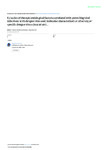Episodes of the epidemiological factors correlated with prevailing viral infections with dengue virus and molecular characterization of serotypespecific dengue virus circulation in eastern India

View/
Date
2018Author
Mulwa, David
Raoa, Rajesh Kumar
Padhyb, Rabindra N.
Dasc, Manoj Kumar
Metadata
Show full item recordAbstract
Background: Dengue is one of the most important and widespread viral infection comprises 4 related serotypes (DEN-1, 2, 3, and 4). Infection with one serotype does not protect against the others, and sequential infections put people at greater risk for dengue hemorrhagic fever (DHF) and dengue shock syndrome (DSS). This study determines the epidemiology of prevailing viral infections with dengue and molecular characterization of serotype-specific DENV circulation in Odisha of eastern India. Methods: During the year 2013, 1980 blood samples with suspected dengue cases were obtained between days 1–10 of illness and analyzed by NS1 Ag-RDT, NS1 Ag-ELISA, and RT-PCR. The differential detection of dengue infections and DENV serotyping were carried out by IgM/IgG Ab-ELISA and RT-PCR, respectively. Results: Of the 1980 samples, 733 (37.0%) were positive for dengue RNA by RT-PCR. The confirmed cases of dengue were more in males (73.6%) in comparing to females (26.4%). The age group of 15–44 years (527 cases, 71.9%) were more susceptible to dengue infections. 656 (89.5%) cases had infected with monotypic infection by different DENV serotype and 77 (10.5%) cases had multitypic infections by multiple serotypes of DENV. Of the total multitypic infections, there were 74 (10.1%) cases had infected with DENV-2 and DENV-3 serotypes at a time; and only 3 (0.4%) cases had the concurrent infections of all three serotypes that were, DENV-1, DENV-2, and DENV-3. Of the 28 DHF cases, there were 17 (2.3%) cases had infected with multitypic infections and 11 (1.5%) cases had infected with monotypic infection. Conclusion: Dengue infections have prevailed from the month of July and grasped it's the peak in September. Rain, temperature and relative humidity have favored the dengue infections. Young adults and males are more susceptible to dengue infections. Serotypes DEN-2 followed by DEN-3 was dominant among the confirmed dengue cases. Co-circulation of multitypic infections with multiple DENV serotypes and the emergence of DHF cases suggested that eastern Indian state Odisha was becoming a hyper-endemic province for dengue; therefore, continuous surveillance is suggested for understanding the epidemiology of the diseases and monitoring the changes in the characteristics of circulating DENV strains.
Collections
- School of Education [203]
